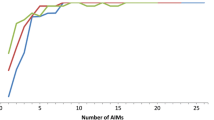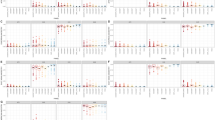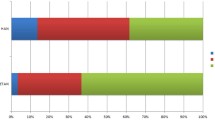Abstract
Ancestry informative markers (AIMs) can be used to determine population affiliation of the donors of forensic samples. In order to examine ancestry evaluations of the four major populations in the USA, 23 highly informative AIMs were identified from the International HapMap project. However, the efficacy of these 23 AIMs could not be fully evaluated in silico. In this study, these 23 SNPs were multiplexed to test their actual performance in ancestry evaluations. Genotype data were obtained from 189 individuals collected from four American populations. One SNP (rs12149261) on chromosome 16 was removed from this panel because it was duplicated on chromosome 1. The resultant 22-AIMs panel was able to empirically resolve the four major populations as in the in silico study. Eight individuals were assigned to a different group than indicated on their samples. The assignments of the 22 AIMs for these samples were consistent with AIMs results from the ForenSeqTM panel. No departures from Hardy-Weinberg equilibrium (HWE) and linkage disequilibrium (LD) were detected for all 22 SNPs in four US populations (after removing the eight problematic samples). The principal component analysis (PCA) results indicated that 181 individuals from these populations were assigned to the expected groups. These 22 SNPs can contribute to the candidate AIMs pool for potential forensic identification purposes in major US populations.

Similar content being viewed by others
References
Rosenberg NA, Pritchard JK, Weber JL, Cann HM, Kidd KK, Zhivotovsky LA, Feldman MW (2002) Genetic structure of human populations. Science 298:2381–2385
Hoggart CJ, Parra EJ, Shriver MD, Bonilla C, Kittles RA, Clayton DG, McKeigue PM (2003) Control of confounding of genetic associations in stratified populations. Am J Hum Genet 72:1492–1504
Shriver MD, Parra EJ, Dios S, Bonilla C, Norton H, Jovel C, Pfaff C, Jones C, Massac A, Cameron N, Baron A, Jackson T, Argyropoulos G, Jin L, Hoggart CJ, McKeigue PM, Kittles RA (2003) Skin pigmentation, biogeographical ancestry and admixture mapping. Hum Genet 112:387–399
Marchini J, Cardon LR, Phillips MS, Donnelly P (2004) The effects of human population structure on large genetic association studies. Nat Genet 36:512–517
Jobling MA, Gill P (2004) Encoded evidence: DNA in forensic analysis. Nat Rev Genet 5:739–751
Yang N, Li H, Criswell LA, Gregersen PK, Alarcon-Riquelme ME, Kittles R, Shigeta R, Silva G, Patel PI, Belmont JW, Seldin MF (2005) Examination of ancestry and ethnic affiliation using highly informative diallelic DNA markers: application to diverse and admixed populations and implications for clinical epidemiology and forensic medicine. Hum Genet 118:382–392
Shriver MD, Kittles RA (2004) Genetic ancestry and the search for personalized genetic histories. Nat Rev Genet 5:611–618
Zeng X, Chakraborty R, King JL, LaRue B, Moura-Neto RS, Budowle B (2015) Selection of highly informative SNP markers for population affiliation of major US populations. Int J Legal Med. doi:10.1007/s00414-015-1297-9
Ding L, Wiener H, Abebe T, Altaye M, Go RC, Kercsmar C, Grabowski G, Martin LJ, Khurana Hershey GK, Chakorborty R, Baye TM (2011) Comparison of measures of marker informativeness for ancestry and admixture mapping. BMC Genomics 12:622
International HapMap Consortium (2003) The International HapMap Project. Nature 426:789–796
1000 Genomes Project Consortium, Abecasis GR, Auton A, Brooks LD, DePristo MA, Durbin RM, Handsaker RE, Kang HM, Marth GT, McVean GA (2012) An integrated map of genetic variation from 1,092 human genomes. Nature 491:56–65
QIAamp® DNA mini and blood mini handbook (2012) https://www.qiagen.com/us/resources/resourcedetail?id=67893a91-946f-49b5-8033-394fa5d752ea&lang=en
Nextera rapid capture enrichment reference guide (2015) https://support.illumina.com/downloads/nextera-rapid-capture-guide-15037436.html
DesignStudio (2015) https://accounts.illumina.com/?ReturnUrl=http://designstudio.illumina.com/
Qubit® dsDNA BR Assay Kit (2015) https://www.thermofisher.com/order/catalog/product/Q32850
McKenna A, Hanna M, Banks E, Sivachenko A, Cibulskis K, Kernytsky A, Garimella K, Altshuler D, Gabriel S, Daly M, DePristo MA (2010) The Genome Analysis Toolkit: a MapReduce framework for analyzing next-generation DNA sequencing data. Genome Res 20:1297–1303
Churchill JD, Schmedes SE, King JL, Budowle B (2015) Evaluation of the Illumina® Beta Version ForenSeq™ DNA Signature Prep Kit for use in genetic profiling. Forensic Sci Int Genet 20:20–29
Lewis PO Zaykin D (2001) Genetic data analysis: computer program for the analysis of allelic data. Version 1.0 (d16c). http://hydrodictyon.eeb.uconn.edu/people/plewis/software.php. Accessed 25 April 2007
Author information
Authors and Affiliations
Corresponding author
Electronic supplementary material
Below is the link to the electronic supplementary material.
Supplemental Table 1
The probe information of the 23 ancestry informative SNPs (XLSX 11.5 kb)
Supplemental Fig. 1
Average coverage of 22 SNPs in 189 individuals (TIFF 815 kb)
Supplemental Fig. 2
Example of sequence data for SNP rs12149261 shown in IGV. The three different individuals (005A, 011 and 35706) were Caucasian, Asian and Hispanic American, respectively (TIFF 2329 Kb)
Supplemental Fig. 3
BLAST results of 300 bp around SNP rs12149261. Supplemental Figure 3A is rs12149261 located in HYDIN gene on chromosome 16. Supplemental Figure 3B is the duplication of rs12149261 located in HYDIN2 gene on chromosome 1 (TIFF 1820 kb)
Supplemental Fig. 4
PCA plots of eight individuals using the ForenSeqTM panel. Eight samples (20882, 23169, 76194, 06498, 12574, 38859, 10916 and 61115) are labeled in red circles in Supplemental Figures 4A-4H, respectively (TIFF 2979 kb)
Supplemental Fig. 5
The PCA plot of 181 individuals using 22-SNP AIMs panel (TIFF 1159 kb)
Rights and permissions
About this article
Cite this article
Zeng, X., Warshauer, D.H., King, J.L. et al. Empirical testing of a 23-AIMs panel of SNPs for ancestry evaluations in four major US populations. Int J Legal Med 130, 891–896 (2016). https://doi.org/10.1007/s00414-016-1333-4
Received:
Accepted:
Published:
Issue Date:
DOI: https://doi.org/10.1007/s00414-016-1333-4




